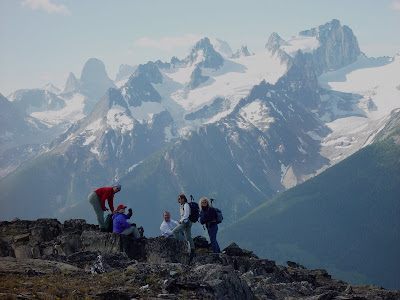
From 1998-2004, I spent my summers guiding hiking trips in the Columbia Mountains of Canada. Those mountains are incredible and it is there where I've had some of the most memorable times of my life. Most memorable of all were the people I met and their inspirational stories.
In 2001, I had a guest whose determination and eternal optimism left an impression on me that I'll never forget. The following is from my journal entry from July of that year.
“We were hiking on a ridge in Canada’s Columbia Mountains called Vertigo. It is a very special place. It is not one of our regular hikes. In fact, only a handful of people in the world had ever been there before. To even consider hiking Vertigo, an absolutely perfect day is in order. It is an exposed, relatively narrow ridge with an intimidating drop on either side.

On that day we were privileged. There were perfect blue skies and only a modest wind. I had been to Vertigo once before (a year earlier) and was quickly reminded why this place was so special: the view is superb - an endless sea of snowcapped peaks.


I was leading my group along the ridge towards the main peak. The peak is somewhat narrow and steep. It is not dangerous but for someone who has little experience in the mountains this hike can really test their courage. When I looked up I noticed another small group making their way down the peak. In that group was a man who I had taken a special interest in during the week. His name was Fred and he was tall, thin, muscular, and probably in his late 40’s or early 50’s (I never asked). He was a former athlete going through the initial stages of multiple sclerosis. As he hiked alongside his wife, I could see his diagnostic limp. He was walking towards me.
During the week, I never gave him special attention or treated him differently from any of my other guests. However, I thought about him a lot. I wondered what went through his mind the weeks, days, and nights before our hiking trip. Was he scared, excited, nervous, afraid of failing, and/or ready for his personal challenge? I did know one thing for certain – I could see that he was coming to terms with the fact that he was losing control of his body. One of his legs was not working very well. At times, I would watch him literally grab his pant leg and pick his leg up to make it go over an obstacle. At times, he stumbled and lost his balance, but he never (not even once) became frustrated. In fact, few people were enjoying themselves more! How could someone who was faced with such a difficult challenge be so enthusiastic? I did not realize it at the time, but he already gave me the answer.
As we walked past each other I smiled at him and said proudly, “Fred you went up there?” He came over to me, grabbed my arm until I stopped walking, and made sure that he had my attention. I could see his eyes well-up. He pointed back to that peak he just ascended and said, “that is the closest I’m ever going to get to Mt. Everest. Those are my Hillary Steps.” He was overcome with emotion.
He showed me that no matter how difficult a challenge one faces (whether it is a small hill on the top of a mountain or facing something as serious as multiple sclerosis) any experience (good or bad) is what you make of it because we cannot control certain things that happen to us.
I have heard similar clichés in the past, but it was this mans reality and now it was my personal experience – it was truly inspirational. He embraced all the positive aspects from his experience when it could have been so easy to become frustrated or to feel sorry for himself.
The rare opportunity to hike Vertigo and the grand scale of all those surrounding mountains were eclipsed by one man’s courage, determination, and sense of adventure. He showed me something that was greater than the mountains, the scenery, and all of nature – his human spirit! He took that beautiful scene and made it better; by giving it emotion, he brought it to life.

He is not the only one. Every time I lead a group into the mountains there are certain individuals who achieve a personal goal and/or overcome a challenge. I frequently see spirits rekindled and a new enthusiasm for life. I used to think that the mountains created this spirit, but now I know that they serve only as a catalyst – the human spirit has been there all along.”







